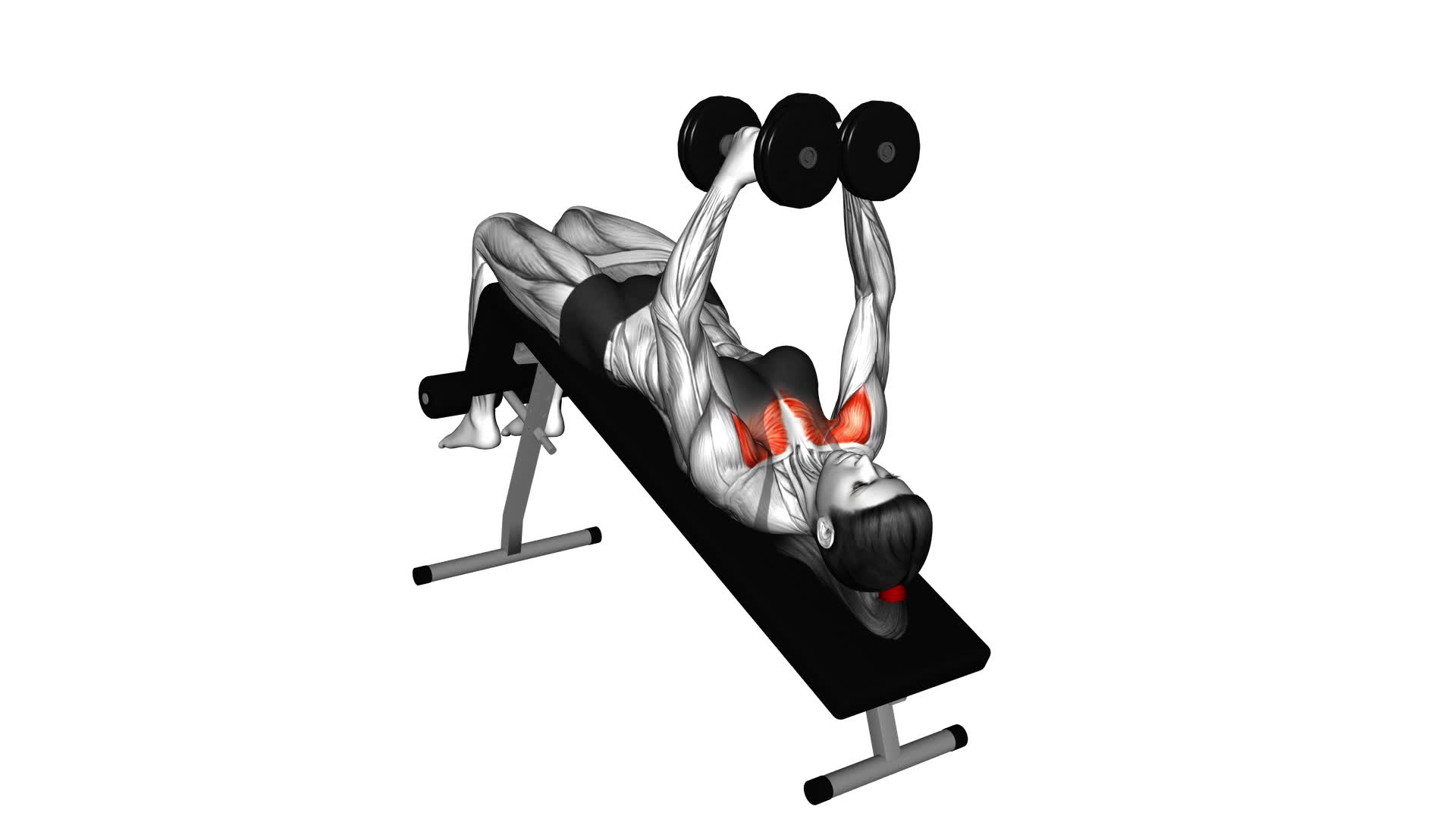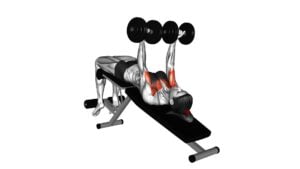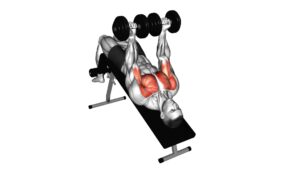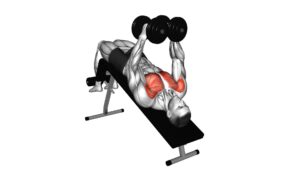Dumbbell Decline Fly (female) – Video Exercise Guide & Tips

Looking to tone your chest muscles? The dumbbell decline fly is a great exercise for you. In this video exercise guide, we'll show you the proper form and provide tips to enhance your workout.
Watch This Exercise Video
Incorporating this exercise into your routine can have numerous benefits, such as increased strength and improved muscle definition. Choose the right dumbbell weight for your fitness level and avoid common mistakes to maximize results.
Get ready to take your workout to the next level!
Key Takeaways
- The dumbbell decline fly targets the pectoralis major muscle and engages other muscles such as the anterior deltoids, triceps, and serratus anterior muscles.
- It is important to choose the right dumbbell weight that allows for proper form and gradually increase the weight for progressive strength building.
- Alternative exercises for chest development include the barbell decline bench press, cable chest fly, and push-up, providing variety in the routine and preventing plateaus.
- Common mistakes include dropping dumbbells too low, swinging, difficulty maintaining form, and experiencing pain or strain. Tips include maintaining a firm grip and straight wrists, keeping elbows slightly bent, varying weight and repetitions, trying different variations, and listening to the body to adjust intensity.
Proper Form for the Dumbbell Decline Fly
To perform the Dumbbell Decline Fly correctly:
- Lie on a decline bench with your feet secured and hold a dumbbell in each hand.
- Start by lying flat on the decline bench with your head at the lower end and your feet securely placed.
- Hold a dumbbell in each hand, with your palms facing each other and your arms fully extended.
- Slowly lower your arms out to the sides in a wide arc until you feel a stretch in your chest muscles.
- Keep your elbows slightly bent throughout the movement to prevent strain on your joints.
- Pause for a moment, then use your chest muscles to bring the dumbbells back up to the starting position.
- It's important to maintain control and avoid using momentum to lift the weights.
- Remember to breathe steadily throughout the exercise and focus on engaging your chest muscles.
Benefits of Incorporating the Dumbbell Decline Fly Into Your Workout Routine
Incorporating the Dumbbell Decline Fly into your workout routine regularly can provide numerous benefits for strengthening and toning your chest muscles. This exercise primarily targets the pectoralis major, which is the main muscle in your chest. It also engages the anterior deltoids, triceps, and serratus anterior muscles to a lesser extent. By performing the Dumbbell Decline Fly, you can effectively isolate and work these muscles, helping to increase their strength and definition.
However, if you're looking for alternative exercises to incorporate into your chest development routine, there are a few options to consider. The first alternative is the Barbell Decline Bench Press, which targets similar muscles but allows you to lift heavier weights. Another alternative is the Cable Chest Fly, which provides a constant tension throughout the movement and allows for a greater range of motion. Lastly, the Push-Up is a great bodyweight exercise that targets the chest muscles and can be modified to suit different fitness levels.
How to Choose the Right Dumbbell Weight for Your Fitness Level
When choosing the right dumbbell weight for your fitness level, it's important to consider your strength and ability to perform the Dumbbell Decline Fly exercise effectively. Choosing the appropriate weight is crucial to ensure that you're challenging your muscles without compromising your form or risking injury.
To determine the right weight for you, start with a weight that you can comfortably lift for 10-12 repetitions with proper form. If this weight feels too easy, gradually increase the weight until you reach a point where you can only complete 8-10 repetitions with good technique. This progressive approach allows you to gradually build strength and prevent overexertion.
It's important to note that the weight you choose may vary depending on the specific exercise. Some exercises may require lighter weights to focus on technique and control, while others may require heavier weights to challenge your muscles more effectively. Listen to your body and adjust the weight accordingly.
Remember, the goal is to challenge yourself without sacrificing proper form. If you find that you're struggling to maintain proper technique or experiencing pain or discomfort, it may be a sign that the weight is too heavy. In this case, decrease the weight and focus on mastering the exercise with correct form before progressing to heavier weights.
Now that you understand how to choose the right dumbbell weight for your fitness level, let's move on to the next section and discuss common mistakes to avoid while performing the dumbbell decline fly.
Common Mistakes to Avoid While Performing the Dumbbell Decline Fly
Avoid dropping the dumbbells too low during the Dumbbell Decline Fly exercise. This common mistake can lead to injuries and diminish the effectiveness of the exercise. To ensure a safe and efficient workout, here are some tips to keep in mind:
- Maintain control: Focus on controlling the movement and avoid swinging the dumbbells. This will help target the intended muscles and reduce the risk of strain or injury.
- Modify the exercise: If you find it difficult to maintain proper form or experience discomfort, consider modifying the exercise. Instead of using dumbbells, try using resistance bands or performing a modified version of the fly exercise.
- Listen to your body: Pay attention to any pain or discomfort during the exercise. If you feel any strain or excessive tension, it's important to stop and assess your form. Consult with a fitness professional or healthcare provider if necessary.
Tips to Enhance Your Dumbbell Decline Fly Workout
To enhance your Dumbbell Decline Fly workout, focus on maintaining proper form and engaging the targeted muscles throughout the exercise. This will maximize the effectiveness of the workout and help you achieve your desired results.
One tip to enhance your workout is to ensure that you have a firm grip on the dumbbells and keep your wrists straight throughout the movement. This will help to engage your chest muscles and prevent any strain on your wrists. Additionally, it's important to keep your elbows slightly bent throughout the exercise to prevent any excessive stress on your joints.
Another tip to enhance your Dumbbell Decline Fly workout is to vary the weight and repetitions based on your fitness level. For beginners, it's recommended to start with lighter weights and perform more repetitions to focus on building endurance and proper form. As you become more advanced, you can increase the weight and decrease the number of repetitions to focus on enhancing muscle growth and strength.
You can also try different variations of the Dumbbell Decline Fly such as using a resistance band or performing the exercise on an inclined bench to further challenge your muscles and add variety to your workout routine.
Remember to always listen to your body and adjust the intensity accordingly to prevent any injuries.
Frequently Asked Questions
Can the Dumbbell Decline Fly Be Modified for Beginners or Those With Limited Upper Body Strength?
Yes, the dumbbell decline fly can be modified for beginners or those with limited upper body strength. There are several modifications you can try.
First, start with lighter weights or resistance bands to reduce the strain on your muscles.
Additionally, you can perform the exercise on an incline bench instead of a decline bench to make it easier.
Remember to focus on proper form and gradually increase the intensity as your strength improves.
Is It Necessary to Perform the Dumbbell Decline Fly on a Decline Bench, or Can It Be Done on a Regular Flat Bench?
You can perform the dumbbell decline fly on a decline bench or a regular flat bench. The decline bench targets the lower chest muscles more intensely, while the flat bench works the middle and upper chest.
Beginners or those with limited upper body strength can modify the exercise by using lighter weights or starting with the flat bench position.
Remember to maintain proper form and gradually increase the difficulty as you progress.
Are There Any Variations or Alternative Exercises That Can Target the Same Muscle Groups as the Dumbbell Decline Fly?
Looking for variations of the dumbbell decline fly or alternative exercises that target the same muscle groups?
There are a few options you can try. One variation is the incline dumbbell fly, which focuses on the upper chest.
Another alternative exercise is the cable crossover, which also targets the chest muscles.
Remember to choose a weight that challenges you but allows you to maintain proper form.
And as always, consult with a professional before starting any new exercise routine.
How Often Should I Incorporate the Dumbbell Decline Fly Into My Workout Routine to See Results?
To see optimal results, it's important to incorporate the dumbbell decline fly into your workout routine at the right frequency.
The dumbbell decline fly is an effective exercise for targeting specific muscle groups.
However, the frequency of incorporating it will depend on your overall workout plan and goals.
It's recommended to consult with a fitness professional to determine the optimal frequency of incorporating the dumbbell decline fly into your routine for best results.
Can the Dumbbell Decline Fly Help With Improving Posture or Targeting Specific Muscle Imbalances?
To improve your posture and target specific muscle imbalances, the dumbbell decline fly can be a beneficial exercise.
By targeting the muscles in your chest, shoulders, and upper back, this exercise can help strengthen and balance these areas, which in turn can improve your overall posture.
Additionally, by working on muscle imbalances, you can address any weaknesses or asymmetries in your upper body, leading to better alignment and posture.
Conclusion
Incorporating the dumbbell decline fly into your workout routine can provide numerous benefits.
This exercise helps to target and strengthen the chest muscles while also engaging the shoulders and arms.
It's important to choose the right dumbbell weight for your fitness level to ensure proper form and avoid injury.
By avoiding common mistakes and following the tips provided, you can enhance your dumbbell decline fly workout and maximize its effectiveness.

Author
Years ago, the spark of my life’s passion ignited in my mind the moment I stepped into the local gym for the first time. The inaugural bead of perspiration, the initial endeavor, the very first surge of endorphins, and a sense of pride that washed over me post-workout marked the beginning of my deep-seated interest in strength sports, fitness, and sports nutrition. This very curiosity blossomed rapidly into a profound fascination, propelling me to earn a Master’s degree in Physical Education from the Academy of Physical Education in Krakow, followed by a Sports Manager diploma from the Jagiellonian University. My journey of growth led me to gain more specialized qualifications, such as being a certified personal trainer with a focus on sports dietetics, a lifeguard, and an instructor for wellness and corrective gymnastics. Theoretical knowledge paired seamlessly with practical experience, reinforcing my belief that the transformation of individuals under my guidance was also a reflection of my personal growth. This belief holds true even today. Each day, I strive to push the boundaries and explore new realms. These realms gently elevate me to greater heights. The unique combination of passion for my field and the continuous quest for growth fuels my drive to break new ground.







